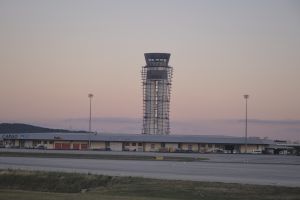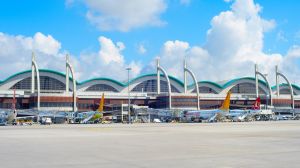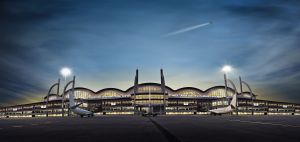Sabiha Gökçen Airport
Sabiha Gökçen Airport (IATA:SAW, ICAO: LTFJ) is the 3rd busiest airport in Turkiye just behind Antalya Airport and 3rd busiest airport in the world that only have single runway. Located in east of Istanbul, the airport is the 23rd in the busiest airport in Europe as per 2022 statistics of EuroControl. The airport has only 1 runway in operation however another one is being built at the moment. Sabiha Gökçen Airport known is used as base for Pegasus Airlines and AnadoluJet.
Sceneries
Payware
There are multiple payware options depending on the simulator for Sabiha Gökçen Airport. You can find more information from the table below.Pay
| Simulator | Developer | Publisher | Links |
|---|---|---|---|
| FSX/P3D | SceneryTR | SimMarket | Simmarket |
Freeware
There are also freeware options available for Sabiha Gökçen Airport. However there is significant difference in quality.
| Simulator | Developer | Publisher | Links |
|---|---|---|---|
| Microsoft Flight Simulator 2020 | Hayri Büberci, Mali Öğüdücü | Turkish Virtual | Turkish Virtual |
| Microsoft Flight Simulator X | Murat Koncavar | Sanal Pilot | Sanal Pilot |
| Microsoft Flight Simulator 2004 | Murat Koncavar | Sanal Pilot | Sanal Pilot |
| X-Plane 11 | Hayri Buberci | Turkish Virtual | Turkish Virtua |
| X-Plane 10 | Hayri Buberci | Turkish Virtual | Turkish Virtua |
Preferential Runway System (PRS)
The term “Preferential RWY System (PRS)” shall be used to indicate the runway that, at a particular time, is considered by the ATC unit to be the most suitable for use by the aircraft expected to land at or take-off from the aerodrome, by taking into consideration aircraft performance, surface wind speed and its components. PRS Operations contribute to the optimum use of airspace and aerodrome capacity.
Preferential RWYs for Sabiha Gökçen Airport (LTFJ) are the north configuration runways (RWY 06L/R)
| RWYCC (Runway Condition Code) | Tail Wind Component (max) |
|---|---|
| RWYCC 6/6/6
(dry, maximum braking) |
10 KT (included) |
| When RWYCC is reported at least 5 for any each runway third
(worse than dry, low braking |
5 KT (included) |
- In the PRS operations, the above wind criteria depending on the runway surface condition shall be applied.
- During the PRS operations, ATC unit takes into account the ground wind, traffic situation, local meteorological conditions, environmental restrictions, technical infrastructure, noise abatement, etc.
- PRS operations will not be available under the following circumstances:
- The instrument approach/departure procedures available for the preferred RWY(s) are not convenient for landing and/ or take-off operations under the existing meteorological conditions
- When the preferred RWY(s) are dry (RWYCC[1] 6/6/6), the tail wind component is greater than 10 Kt,
- When RWYCC is reported at least 5 for any each the preferred RWY(s) third, the tail wind component is greater than 5 Kt,
- When RWYCC is reported at least 5 for any each the preferred RWY(s) third, there is a NOTAM/equivalent information (which may be included in the RCR) stating that the runway is slippery,ATIS announcement when PRS Operations are in progress shall be; “Preferential Runway Operations are in Progress”.
- RWYCC is reported 4 or less any each the preferred RWY(s) third,
- Meteorological conditions such as heavy rainfall, thunderstorm or wind-shear has been reported on the approach or climb path of the preferred RWY(s),
- Low visibility operations are in progress.
- ATIS announcement when PRS Operations are in progress shall be; “Preferential Runway Operations are in Progress”.
- Pilots unable to comply with PRS Operations shall notify the relevant ATC unit at the time of requesting start-up clearance, at the first contact or 20 minutes in advance of the ETA (which is earlier).
Arrival Procedures
Introduction
Sabiha Gökçen Airport is located within Yesilkoy TMA (Terminal Manoeuvring Area). Yesilkoy TMA covers Istanbul Airport (LTFM), Sabiha Gökçen Airport (LTFJ), Ataturk Airport (LTBA), Samandira Airbase (LTBX), Corlu Ataturk Airport (LTBU), Hezarfen Municipal Airport (LTBW), Cengiz Topel Airport (LTBQ), Bursa Yunuseli Airport (LTBE) and Bursa Yenisehir Airport (LTBQ).
Sabiha Gökçen Airpor utilizes RNAV in all of its procedures. In addition, P-RNAV (Precision-Area Navigation, RNP1) capability is required. If unable, pilots must inform the controller so that aircraft can be given radar vectors to final. Arrival into Sabiha Gökçen Airport might seem complicated to some pilots however it is actually very simple. STARs utilize PMS (Point Merge System) for efficient airspace control, separation, and to control traffic flow within Yesilkoy TMA. All STARs utilize idle descent philosophy until PMS entry. These point merge systems act as an arc of a circle and ease air traffic control.
Important things to keep in mind:
- Vacating aircraft has priority at the intersection of the parallel taxiway. Which means, if you are vacating a RWY using rapid exit, the traffic on D should stop for you.
- After the runway is vacated, do not report vacated to TWR* and DO NOT STOP on rapid-exit taxiways.
*unless LVP is in progress. Check next section for more details.
Low Visibility Procedure
- When LVP are in progress, every traffic must report "Vacated" to the TWR, as verbal confirmation from the traffic is mandatory and for the TWR to know the runway is available for the next traffic.
- Traffics shall report lift-off information when airborne if requested by ATC. Then connect immediately to approach
STARs
The Stars at Gökçen are unlike LTFM, less complex but very useful. There are no IAF's at LTFJ. Pilot needs to follow the STAR and execute assigned ILS procedure at ASDEV (RWY 06) or BEMKA (RWY 24).
| Active Runway Configuration | ||||||
|---|---|---|---|---|---|---|
North Configuration (RWY 06) uses the following STAR identifiers.
*Alternative: Only used/issued by ATC. | ||||||
South Configuration (RWY 24) uses the following STAR identifiers.
*Alternative: Only used/issued by ATC. |
As Sabiha Gökçen Airport utilizes multiple configurations depending on traffic, weather, congestion, NOTAMs etc. You might be cleared to a different STAR compared to another traffic that is flying exactly the same route as you. Default designators for northern config (RWY 06) is 1G and default designator for southern configuration (RWY 24) is 1H. The procedures and STARs for Sabiha Gökçen Airport were built to utilize Yesilkoy TMA most efficiently with the Istanbul Airport (LTFM) STARs.
North Config
South Config
Local Traffic Regulations
Procedures For Departing and Landing Aircraft
- Pilots of departing aircraft are reminded to contact ATC for ATC clearance 10 minutes before start-up.
- The start-up according to EOBT is under pilot’s responsibility.
- The departure radar sector frequency will not be given by tower unless it is different than given by ATIS or clearance delivery,
- Push back shall not be requested unless full ready. When cleared by ATC, traffic should start to push back within 60 seconds.
- Runway vacating should not be reported to Tower frequency unless instructed by Tower. Pilots shall contact to ground frequency 121.750 MHZ (if online) after vacating runway.
- All aircraft vacating a RWY via Rapid Exit Taxiway has the priority at the intersection of the taxiways, over the aircraft taxiing on other taxiways. All pilots shall be cautious about this priority and unless otherwise instructed not to do so, give way to the aircraft vacating a RWY via one of the Rapid Exit Taxiways.
QNH & Transition Level
During the approach phase of arriving aircraft, LTBA QNH and TL values given by YESLIKOY APP shall be used. LTFJ QNH value will be given on first contact to Gökçen Tower.
Pilot Reaction and Runway Occupation Time
- Pilot’s reaction time shall not be exceed 10 seconds for departure clearance and 60 seconds for push-back clearance.
- If pilots are unable to comply these rules they should inform tower as soon as possible.
- Landing aircraft shall vacate runway via the most appropriate taxiway whose distances are indicated in the following table to reduce runway occupation time. The given distances in the table are not Declared Distances“but only for guidance.
| Landing Runway | U | H | T | F |
| 06 | - | - | 1602 M | 1953 M |
| 24 | 1479 M | 1953 M | - | - |
- After landing, flight crew are invited to vacate the RWY as fast and safely as possible, by using distances which is given above of rapid exit TWYs T or F for the RWY 06 and TWYs U or H for the RWY 24. If unable, inform Gökçen TWR as soon as possible. After landing, it is recommended that vacating RWY from TWY G should be planned if the vacating the RWY is accurate and safe, otherwise, vacating the RWY by using TWY “G” shall not be attempted. The distances mentioned in the table do not mean “Declared Distances” but are given only for guidance.
Standard Push-back Procedures
- Standard push-back procedures are mandatory for all parking positions except parking positions 14A, 15A, 51, 52, 53 and 54. Power back is forbidden by using reverse thrust. Unless otherwise notified by ground control, push-back shall be done to the direction of the runway in use with the exceptions below. For stand numbers 112 and 113 pushback shall always be done towards east. (nose of ACFT towards RWY 24). For Apron 6, Apron 7 and Apron 8 pushback shall always be done nose of ACFT towards north.
- For stand numbers 1 and 2 push-back shall be done to the west (nose of aircraft will be face to the RWY 06)
- For stand numbers 301 and 308, push back shall be done to Apron exit.
- For stand numbers 402, 402A, 402B, 403, 403A, 403B, 404, 405, 406 and 407 push-back shall be done to the west (nose of aircraft will be faced to the RWY 06).
- Aircraft standing at 404 and 405 parking positions, should not start the engine during push-back, engine start will be done after the aircraft get on the apron centreline.
Advanced Surface Movement Guidance and Control System
Sabiha Gökçen Airport is equipped with mode-S capable advanced surface movement guidance and control system (A-SMGCS). Pilots, must ensure that, aircraft transponder is set to transmit mode-S signals and associated mode-A code, from the request for push-back or taxi, whichever is earlier and after landing, continuously until aircraft is fully parked on stand.
- ↑ Runway Condition Code





